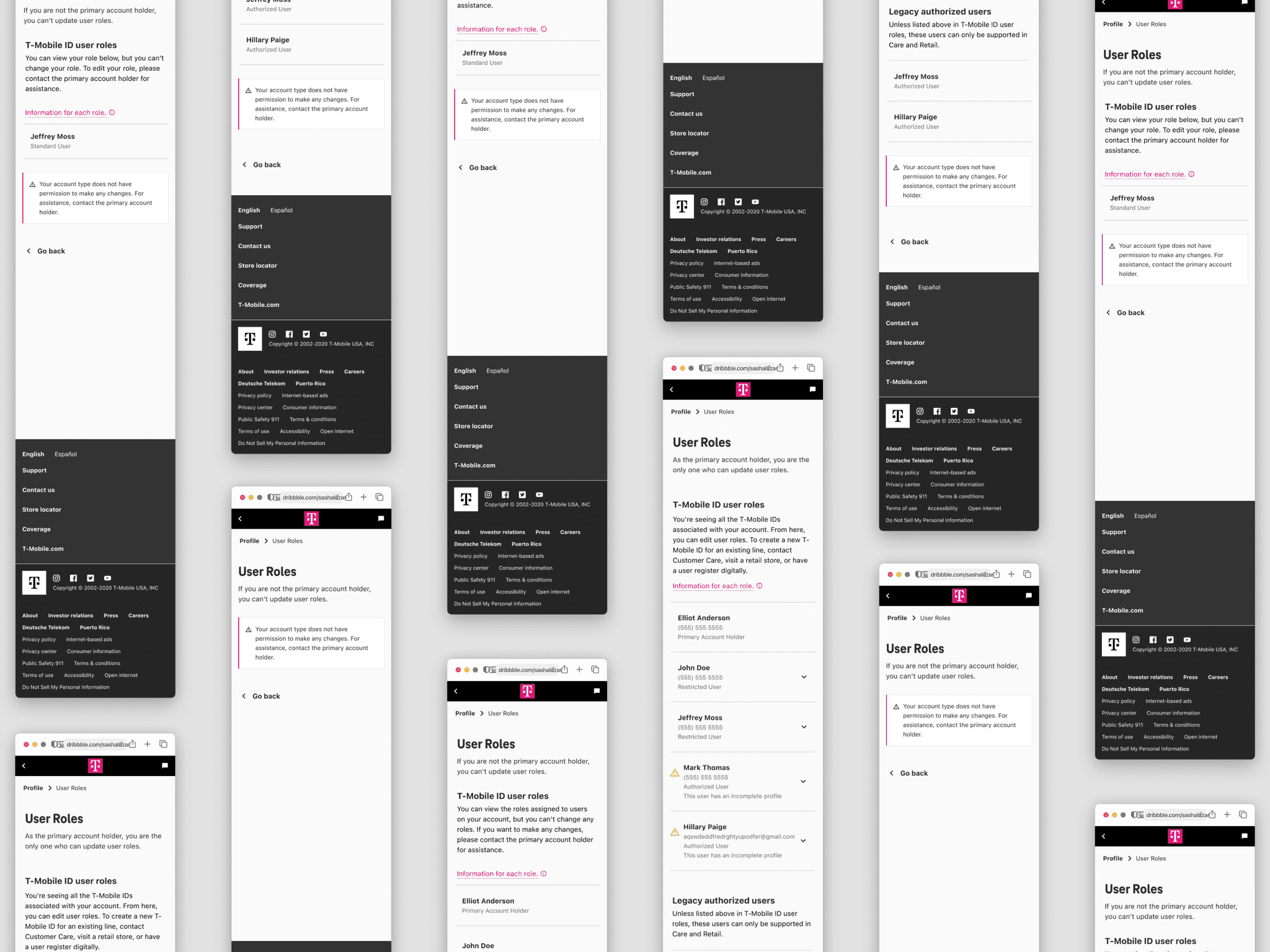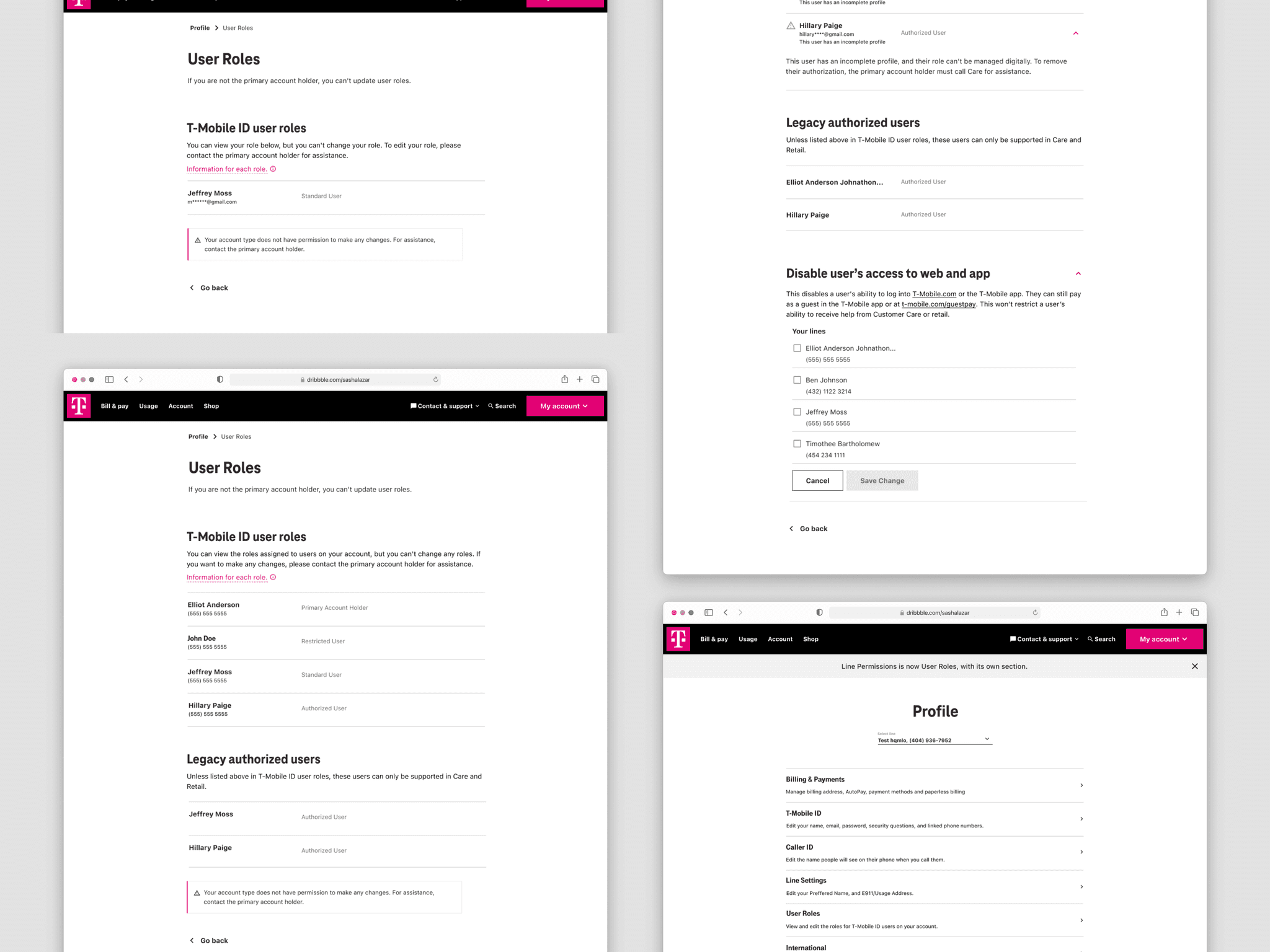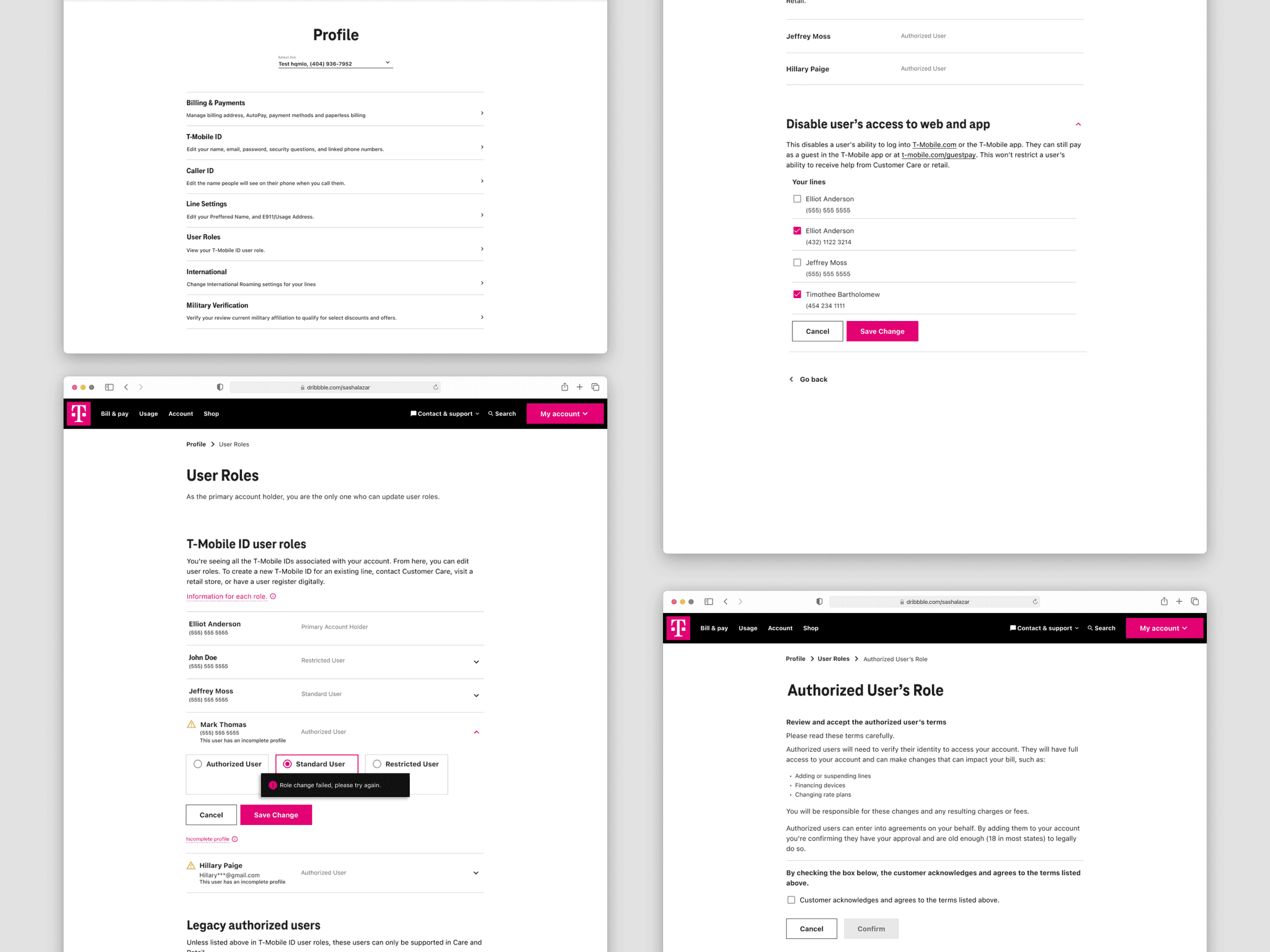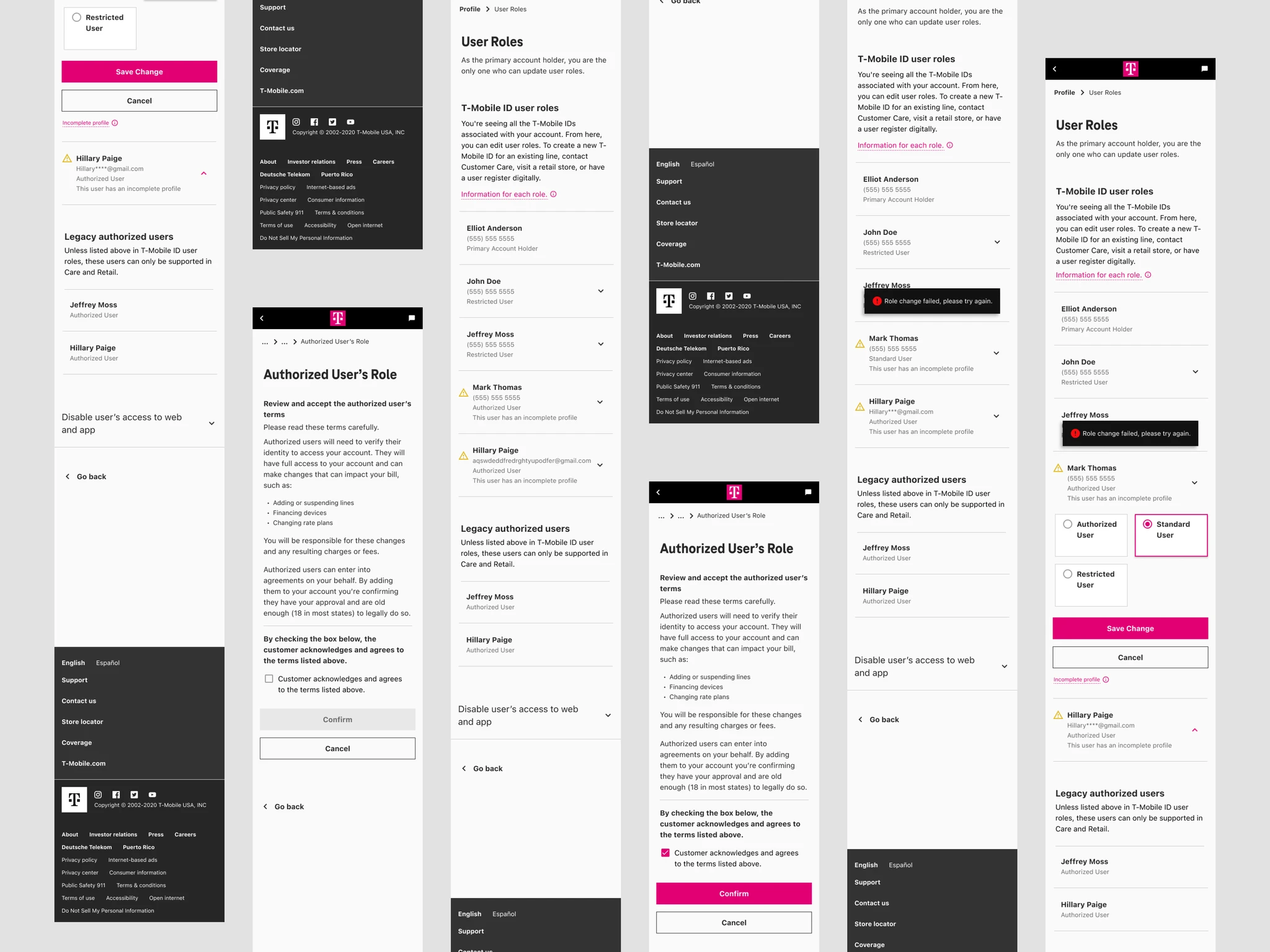Web
Web
Web
Mobile
Mobile
Mobile
App
App
App
Introducing T-Mobile IDs
Introducing T-Mobile IDs
Introducing T-Mobile IDs
Introducing T-Mobile IDs
Introducing T-Mobile IDs
The F&BV Digital Profile project aimed to update the existing line permissions page and overall user experience. The focus was on transitioning from using MSISDNs (phone numbers) to T-Mobile IDs, paving the way for T-Mobile IDs to be used for all T-Mobile products and services.
There are 4 different roles every user can have which are primary account holder, authorized user, standard user, and restricted user.
The F&BV Digital Profile project aimed to update the existing line permissions page and overall user experience. The focus was on transitioning from using MSISDNs (phone numbers) to T-Mobile IDs, paving the way for T-Mobile IDs to be used for all T-Mobile products and services.
There are 4 different roles every user can have which are primary account holder, authorized user, standard user, and restricted user.
The F&BV Digital Profile project aimed to update the existing line permissions page and overall user experience. The focus was on transitioning from using MSISDNs (phone numbers) to T-Mobile IDs, paving the way for T-Mobile IDs to be used for all T-Mobile products and services.
There are 4 different roles every user can have which are primary account holder, authorized user, standard user, and restricted user.
The F&BV Digital Profile project aimed to update the existing line permissions page and overall user experience. The focus was on transitioning from using MSISDNs (phone numbers) to T-Mobile IDs, paving the way for T-Mobile IDs to be used for all T-Mobile products and services.
There are 4 different roles every user can have which are primary account holder, authorized user, standard user, and restricted user.
The F&BV Digital Profile project aimed to update the existing line permissions page and overall user experience. The focus was on transitioning from using MSISDNs (phone numbers) to T-Mobile IDs, paving the way for T-Mobile IDs to be used for all T-Mobile products and services.
There are 4 different roles every user can have which are primary account holder, authorized user, standard user, and restricted user.
2022
Timeline
UX Designer
My Role
Dev Manager, Product Owner, Project Manager, Copywriter
Dev Manager, Product Owner, Project Manager, Copywriter
Dev Manager, Product Owner, Project Manager, Copywriter
Dev Manager, Product Owner, Project Manager, Copywriter
The Team
Our success
My contract with T-Mobile ended right at the completion of this project, so I do not have any metrics to share. However, I know that this project enabled T-Mobile to kickstart its push to use T-Mobile IDs across all of T-Mobile; previously, they were only for T-Mobile Digital.
T-Mobile is comprised of T-Mobile Digital, Retail, and Business.





Mobile view of the different T-Mobile ID user role pages.
Streamline account management with T-Mobile IDs
Streamline account management with T-Mobile IDs
The primary objective was to enhance the line permissions page and overall experience by transitioning to T-Mobile IDs for all customers to create a unified sign-on experience.
This transition allowed customers, including those without traditional phone numbers—such as T-Mobile Home Internet users—to manage their accounts seamlessly.
The primary objective was to enhance the line permissions page and overall experience by transitioning to T-Mobile IDs for all customers to create a unified sign-on experience.
This transition allowed customers, including those without traditional phone numbers—such as T-Mobile Home Internet users—to manage their accounts seamlessly.
Tackling T-Mobile ID integration
Tackling T-Mobile ID integration
On the backend, user roles were still connected to MSISDNs, so we needed to create an experience that not only appeared but worked as though they were linked to T-Mobile IDs.
The complexity increased for users with multiple lines attached to their T-Mobile ID, as we had to determine how to assign appropriate user roles to these users.
For instance, when a user had two or more lines linked to their T-Mobile ID, we had to carefully design the experience to handle multiple MSISDNs and determine the suitable user role for them.
On the backend, user roles were still connected to MSISDNs, so we needed to create an experience that not only appeared but worked as though they were linked to T-Mobile IDs.
The complexity increased for users with multiple lines attached to their T-Mobile ID, as we had to determine how to assign appropriate user roles to these users.
For instance, when a user had two or more lines linked to their T-Mobile ID, we had to carefully design the experience to handle multiple MSISDNs and determine the suitable user role for them.





Web view of the different T-Mobile ID user role pages.
Our approach
Our approach
Reimagining the scope
This project started with tight deadlines and a limited budget, initially scoped as a UI update for a single page. Recognizing the need for more than just a design update, I showed stakeholders that the functionality required to change, not just visuals.
Understanding user roles
Using previous research, I identified users’ preferred terminology for different roles, each with distinct access levels (e.g., full privileges for the primary account holder).
Collaborating for success
Close coordination with the development team was essential due to technical constraints. I maintained regular communication through meetings, Slack, and email to ensure the design met user needs.
Exploring solutions
We tested several approaches, including displaying each phone number individually, which would have caused the same T-Mobile ID to appear multiple times. These alternatives were either technically unfeasible or didn’t provide the desired user experience.
Finalizing the approach
We chose to list all phone numbers associated with each T-Mobile ID together and automatically updated them to the highest user role when changes were made. This approach allowed the T-Mobile ID itself to determine user roles, while still technically linking roles to individual phone numbers, overriding the lesser roles.
Reimagining the scope
This project started with tight deadlines and a limited budget, initially scoped as a UI update for a single page. Recognizing the need for more than just a design update, I showed stakeholders that the functionality required to change, not just visuals.
Understanding user roles
Using previous research, I identified users’ preferred terminology for different roles, each with distinct access levels (e.g., full privileges for the primary account holder).
Collaborating for success
Close coordination with the development team was essential due to technical constraints. I maintained regular communication through meetings, Slack, and email to ensure the design met user needs.
Exploring solutions
We tested several approaches, including displaying each phone number individually, which would have caused the same T-Mobile ID to appear multiple times. These alternatives were either technically unfeasible or didn’t provide the desired user experience.
Finalizing the approach
We chose to list all phone numbers associated with each T-Mobile ID together and automatically updated them to the highest user role when changes were made. This approach allowed the T-Mobile ID itself to determine user roles, while still technically linking roles to individual phone numbers, overriding the lesser roles.





Different pages from the web experience. Profile page, disable user's access, failed user role change, authorized user confirmation.
Legacy authorized users
Legacy authorized users
This section is only on some accounts that a retail store created in the past. It's an old system that's been replaced but hasn't been fully phased out yet.
No user can edit someone's role in this section, they must call support or go to a T-Mobile store for help. It's not a common occurrence but something we had to account for.
This section is only on some accounts that a retail store created in the past. It's an old system that's been replaced but hasn't been fully phased out yet.
No user can edit someone's role in this section, they must call support or go to a T-Mobile store for help. It's not a common occurrence but something we had to account for.
Disabling a user's access
Disabling a user's access
Another feature on this page is "disable user's access to web and app," a feature created in case someone's phone is lost, stolen or compromised.
The primary account holder can disable that person's access to their T-Mobile account on the web and app, stopping any unwanted person from getting into the account.
Another feature on this page is "disable user's access to web and app," a feature created in case someone's phone is lost, stolen or compromised.
The primary account holder can disable that person's access to their T-Mobile account on the web and app, stopping any unwanted person from getting into the account.





Authorized user's role confirmation and T-Mobile ID user role pages

